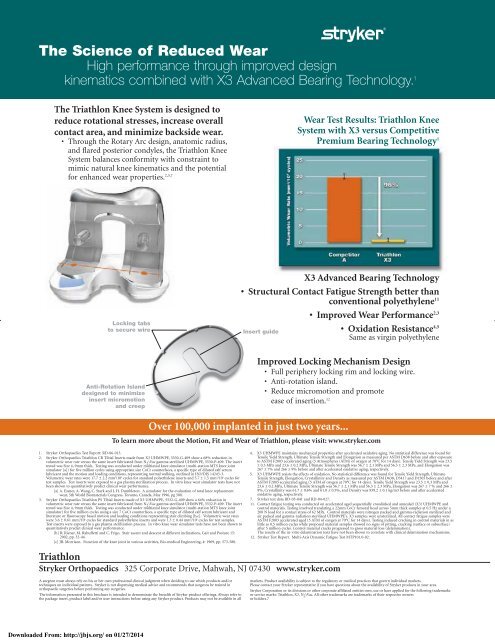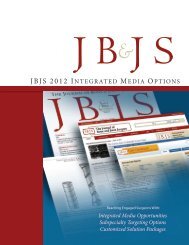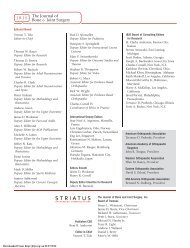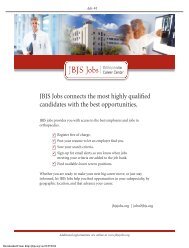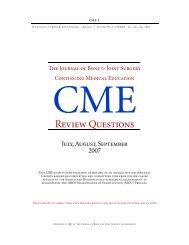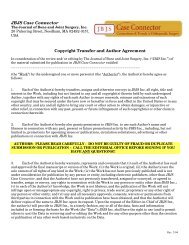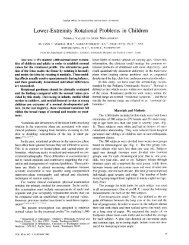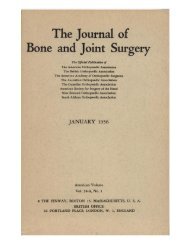Front Matter - The Journal of Bone & Joint Surgery
Front Matter - The Journal of Bone & Joint Surgery
Front Matter - The Journal of Bone & Joint Surgery
Create successful ePaper yourself
Turn your PDF publications into a flip-book with our unique Google optimized e-Paper software.
<strong>The</strong> Science <strong>of</strong> Reduced Wear<br />
High performance through improved design<br />
kinematics combined with X3 Advanced Bearing Technology. 1<br />
<strong>The</strong> Triathlon Knee System is designed to<br />
reduce rotational stresses, increase overall<br />
contact area, and minimize backside wear.<br />
• Through the Rotary Arc design, anatomic radius,<br />
and flared posterior condyles, the Triathlon Knee<br />
System balances conformity with constraint to<br />
mimic natural knee kinematics and the potential<br />
for enhanced wear properties. 2,3,7<br />
Wear Test Results: Triathlon Knee<br />
System with X3 versus Competitive<br />
Premium Bearing Technology 1<br />
X3 Advanced Bearing Technology<br />
• Structural Contact Fatigue Strength better than<br />
conventional polyethylene 11<br />
Locking tabs<br />
to secure wire<br />
Insert guide<br />
• Improved Wear Performance 2,3<br />
• Oxidation Resistance 4,5<br />
Same as virgin polyethylene<br />
Anti-Rotation Island<br />
designed to minimize<br />
insert micromotion<br />
and creep<br />
Improved Locking Mechanism Design<br />
• Full periphery locking rim and locking wire.<br />
• Anti-rotation island.<br />
• Reduce micromotion and promote<br />
ease <strong>of</strong> insertion. 12<br />
Over 100,000 implanted in just two years...<br />
To learn more about the Motion, Fit and Wear <strong>of</strong> Triathlon, please visit: www.stryker.com<br />
1. Stryker Orthopaedics Test Report: RD-06-013.<br />
2. Stryker Orthopaedics Triathlon CR Tibial Inserts made from X3 UHMWPE, 5530-G-409 show a 68% reduction in<br />
volumetric wear rate versus the same insert fabricated from N 2 \Vac gamma sterilized UHMWPE, 5530-P-409. <strong>The</strong> insert<br />
tested was Size 4, 9mm thick. Testing was conducted under multiaxial knee simulator (multi-station MTS knee joint<br />
simulator [a]) for five million cycles using appropriate size CoCr counterfaces, a specific type <strong>of</strong> diluted calf serum<br />
lubricant and the motion and loading conditions, representing normal walking, outlined in ISO/DIS 14243-3.<br />
Volumetric wear rates were 17.7 ± 2.2 mm 3 /10 6 cycles for standard polyethylene inserts and 5.7 ± 1.5 mm 3 /10 6 cycles for<br />
test samples. Test inserts were exposed to a gas plasma sterilization process. In vitro knee wear simulator tests have not<br />
been shown to quantitatively predict clinical wear performance.<br />
[a] A. Essner, A. Wang, C. Stark and J. H. Dumbleton. A simulator for the evaluation <strong>of</strong> total knee replacement<br />
wear, 5th World Biomaterials Congress, Toronto, Canada, May 1996, pg 580.<br />
3. Stryker Orthopaedics Triathlon PS Tibial Inserts made <strong>of</strong> X3 UHMWPE, 5532-G-409 show a 64% reduction in<br />
volumetric wear rate versus the same insert fabricated from N 2 \Vac gamma sterilized UHMWPE, 5532-P-409. <strong>The</strong> insert<br />
tested was Size 4, 9mm thick. Testing was conducted under multiaxial knee simulator (multi-station MTS knee joint<br />
simulator) for five million cycles using a size 7 CoCr counterfaces, a specific type <strong>of</strong> diluted calf serum lubricant and<br />
literature or fluoroscopy based motion and loading conditions representing stair climbing [b,c]. Volumetric wear rates<br />
were 3.6 ± 0.61 mm 3 /10 6 cycles for standard polyethylene inserts and were 1.3 ± 0.44 mm 3 /10 6 cycles for test samples.<br />
Test inserts were exposed to a gas plasma sterilization process. In vitro knee wear simulator tests have not been shown to<br />
quantitatively predict clinical wear performance.<br />
[b] R. Riener, M. Rabuffetti and C. Frigo. Stair ascent and descent at different inclinations, Gait and Posture 15:<br />
2002, pp. 32-44.<br />
[c] JB. Morrison. Function <strong>of</strong> the knee joint in various activities, Bio-medical Engineering, 4: 1969, pp. 573-580.<br />
4. X3 UHMWPE maintains mechanical properties after accelerated oxidative aging. No statistical difference was found for<br />
Tensile Yield Strength, Ultimate Tensile Strength and Elongation as measured per ASTM D638 before and after exposure<br />
to ASTM F2003 accelerated aging (5 Atmospheres (ATM) <strong>of</strong> oxygen at 70°C for 14 days). Tensile Yield Strength was 23.5<br />
± 0.3 MPa and 23.6 ± 0.2 MPa, Ultimate Tensile Strength was 56.7 ± 2.1 MPa and 56.3 ± 2.3 MPa, and Elongation was<br />
267 ± 7% and 266 ± 9% before and after accelerated oxidative aging, respectively.<br />
5. X3 UHMWPE resists the effects <strong>of</strong> oxidation. No statistical difference was found for Tensile Yield Strength, Ultimate<br />
Tensile Strength, Elongation, Crystallinity and Density as measured per ASTM D638, D3417 and D1505 before and after<br />
ASTM F2003 accelerated aging (5 ATM <strong>of</strong> oxygen at 70°C for 14 days). Tensile Yield Strength was 23.5 ± 0.3 MPa and<br />
23.6 ± 0.2 MPa, Ultimate Tensile Strength was 56.7 ± 2.1 MPa and 56.3 ± 2.3 MPa, Elongation was 267 ±7%and266±<br />
9%, Crystallinity was 61.7 ± 0.6% and 61.0 ± 0.5%, and Density was 939.2 ± 0.1 kg/m3 before and after accelerated<br />
oxidative aging, respectively.<br />
7. Stryker test data RD-03-041 and RD-04-027.<br />
11. Contact fatigue testing was conducted on accelerated aged sequentially crosslinked and annealed (X3) UHMWPE and<br />
control materials. Testing involved translating a 22mm CoCr femoral head across 5mm thick samples at 0.5 Hz under a<br />
200 N load for a contact stress <strong>of</strong> 62 MPa. Control materials were nitrogen packed and gamma-radiation sterilized and<br />
air packed and gamma-radiation sterilized UHMWPE’s. X3 samples were unsterilized. All contact fatigue samples were<br />
ASTM F2003 accelerated aged (5 ATM <strong>of</strong> oxygen at 70°C for 14 days). Testing induced cracking in control materials in as<br />
little as 0.5 million cycles while proposed material samples showed no signs <strong>of</strong> pitting, cracking (surface or subsurface)<br />
after 5 million cycles. Control material cracks progressed to gross material loss (delamination).<br />
<strong>The</strong> results <strong>of</strong> the in-vitro delamination tests have not been shown to correlate with clinical delamination mechanisms.<br />
12. Stryker Test Report. Multi-Axis Dynamic Fatigue Test MTP101.0-02.<br />
Triathlon<br />
Stryker Orthopaedics 325 Corporate Drive, Mahwah, NJ 07430 www.stryker.com<br />
A surgeon must always rely on his or her own pr<strong>of</strong>essional clinical judgment when deciding to use which products and/or<br />
techniques on individual patients. Stryker is not dispensing medical advice and recommends that surgeons be trained in<br />
orthopaedic surgeries before performing any surgeries.<br />
<strong>The</strong> information presented in this brochure is intended to demonstrate the breadth <strong>of</strong> Stryker product <strong>of</strong>ferings. Always refer to<br />
the package insert, product label and/or user instructions before using any Stryker product. Products may not be available in all<br />
markets. Product availability is subject to the regulatory or medical practices that govern individual markets.<br />
Please contact your Stryker representative if you have questions about the availability <strong>of</strong> Stryker products in your area.<br />
Stryker Corporation or its divisions or other corporate affiliated entities own, use or have applied for the following trademarks<br />
or service marks: Triathlon, X3, N 2 \Vac. All other trademarks are trademarks <strong>of</strong> their respective owners<br />
or holders.7<br />
Downloaded From: http://jbjs.org/ on 01/27/2014


